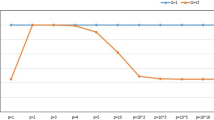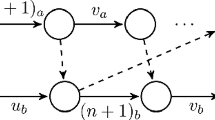Abstract
Refurbished products are gaining importance in many industrial sectors, specifically high-value products whose residual value is relevant and guarantee the economic viability of the remanufacturing at an industrial level, e.g., turbine blades for power generation. In this paper we address the scheduling of re-manufacturing activities for turbine blades. Parts entering the process may have very different wear state or presence of defects. Thus, the repair process is affected by a significant degree of uncertainty. To cope with this, the proposed approach pursues robust schedules minimizing the risk associated to a timely completion time. An approximate branch and bound algorithm is developed grounding on the estimation of the lower bound of the makespan. The viability and efficiency of the approach is assessed through computational experiments grounding on the industrial case under study and a comparison is operated among alternative scheduling approaches.
Access this chapter
Tax calculation will be finalised at checkout
Purchases are for personal use only
Similar content being viewed by others
References
Johnson MR, McCarthy IP (2014) Product recovery decisions within the context of extended producer responsibility. J Eng Tech Manage 34:9–28
Tolio T et al (2017) Design, management and control of demanufacturing and remanufacturing systems. CIRP Annals 66(2):585–609
Diani M, Colledani M (2020) Cyber-physical systems formalization in de-and remanufacturing and application to size reduction stage. Procedia CIRP 91:741–746
Bhagi LK, Rastogi V, Gupta P (2013) Fractographic investigations of the failure of L-1 low pressure steam turbine blade. Case Stud Eng Failure Anal 1(2):72–78
Gong G et al (2020) Remanufacturing-oriented process planning and scheduling: mathematical modelling and evolutionary optimisation. Int J Prod Res 58(12):3781–3799
Philippe J (2007) Value at risk: the new benchmark for managing financial risk. The McGraw-Hill Companies, Inc
Campbell R, Huisman R, Koedijk K (2001) Optimal portfolio selection in a Value-at-Risk framework. J Bank Finance 25(9):1789–1804
Morgan SD, Gagnon RJ (2013) A systematic literature review of remanufacturing scheduling. Int J Prod Res 51(16):4853–4879
Guide V, Daniel R, Kraus ME, Srivastava R (1997) Scheduling policies for remanufacturing. Int J Prod Econ 48(2):187–204
Johnson SM (1954) Optimal two-and three-stage production schedules with setup times included. Naval Res Logist Q 1(1):61–68
Emmons H, Vairaktarakis G (2012) Flow shop scheduling: theoretical results, algorithms, and applications, vol 182. Springer Science & Business Media
Gourgand M, Grangeon N, Norre S (2000) A review of the static stochastic flow-shop scheduling problem. J Decis Syst 9(2):1–31
Talwar PP (1967) A note on sequencing problems with uncertain job times. J Oper Res Soc Jpn 9(3–4):93–97
Cunningham AA, Dutta SK (1973) Scheduling jobs, with exponentially distributed processing times, on two machines of a flow shop. Nav Res Logist Q 20(1):69–81
Pinedo M (1982) Minimizing the expected makespan in stochastic flow shops. Oper Res 30(1):148–162
Baker KR, Trietsch D (2011) Three heuristic procedures for the stochastic, two-machine flow shop problem. J Sched 14(5):445–454
Kouvelis P, Daniels RL, Vairaktarakis G (2000) Robust scheduling of a two-machine flow shop with uncertain processing times. IIE Trans 32(5):421–432
Tolio T, Urgo M (2013) Design of flexible transfer lines: A case-based reconfiguration cost assessment. J Manuf Syst 32(2):325–334
Urgo M, Váncza J (2019) A branch-and-bound approach for the single machine maximum lateness stochastic scheduling problem to minimize the value-at-risk. Flex Serv Manuf J 31(2):472–496
Filippi C, Guastaroba G, Speranza MG (2020) Conditional value‐at‐risk beyond finance: a survey. Int Trans Oper Res 27(3):1277–1319
Alfieri A, Tolio T, Urgo M (2012) A two-stage stochastic programming project scheduling approach to production planning. Int J Adv Manuf Technol 62(1):279–290
Radke AM et al (2013) A risk management-based evaluation of inventory allocations for make-to-order production. CIRP Annals 62(1):459–462
Buergin J et al (2019) Robust assignment of customer orders with uncertain configurations in a production network for aircraft manufacturing. Int J Prod Res 57(3):749–763
Urgo M (2019) A branch-and-bound approach to schedule a no-wait flow shop to minimize the CVaR of the residual work content. Comput Ind Eng 129:67–75
Tolio T, Urgo M, Váncza J (2011) Robust production control against propagation of disruptions. CIRP Ann 60(1):489–492
Sarin SC, Sherali HD, Liao L (2014) Minimizing conditional-value-at-risk for stochastic scheduling problems. J Sched 17(1):5–15
Atakan S, Bülbül K, Noyan N (2017) Minimizing value-at-risk in single-machine scheduling. Ann Oper Res 248(1–2):25–73
Chang Z et al (2017) Distributionally robust single machine scheduling with risk aversion. Eur J Oper Res 256(1):261–274
Kasperski A, Zieliński P (2019) Risk-averse single machine scheduling: complexity and approximation. J Sched 22(5):567–580
Meloni C, Pranzo M (2020) Expected shortfall for the makespan in activity networks under imperfect information. Flex Serv Manuf J 32(3):668–692
Rockafellar RT, Uryasev S (2002) Conditional value-at-risk for general loss distributions. J Bank Financ 26(7):1443–1471
Pinedo M (2012) Scheduling, vol 29. Springer, New York
Carlier J (1982) The one-machine sequencing problem. Eur J Oper Res 11(1):42–47
Gmys J et al (2020) A computationally efficient branch-and-bound algorithm for the permutation flow-shop scheduling problem. Eur J Oper Res 284(3):814–833
Ludwig A, Möhring RH, Stork F (2001) A computational study on bounding the makespan distribution in stochastic project networks. Ann Oper Res 102(1):49–64
Schmidt CW, Grossmann IE (2000) The exact overall time distribution of a project with uncertain task durations. Eur J Oper Res 126(3):614–636
Demeulemeester EL, Herroelen WS (2006) Project scheduling: a research handbook, vol 49. Springer Science & Business Media
Ragsdale C (1989) The current state of network simulation in project management theory and practice. Omega 17(1):21–25
Djerrah A et al (2006) Bob++: Framework for solving optimization problems with branch-and-bound methods. In: 2006 15th IEEE international conference on high performance distributed computing. IEEE.
Boost (2020) Boost C++ Libraries, http://www.boost.org/
Wikipedia page (2021) https://en.wikipedia.org/wiki/Turbine_blade, Accessed 04 Mar 2021
Kolagar AM et al (2017) Failure analysis of gas turbine first stage blade made of nickel-based superalloy. Case Stud Eng Fail Anal 8:61–68
Acknowledgements
We thank Ansaldo Energia for the support in the definition of the requirements in relation to the planning and scheduling of remanufacturing activities for turbine blades.
Author information
Authors and Affiliations
Corresponding author
Editor information
Editors and Affiliations
Rights and permissions
Copyright information
© 2022 The Author(s), under exclusive license to Springer Nature Switzerland AG
About this chapter
Cite this chapter
Liu, L., Urgo, M. (2022). Scheduling Remanufacturing Activities for the Repair of Turbine Blades: An Approximate Branch and Bound Approach to Minimize a Risk Measure. In: Carrino, L., Tolio, T. (eds) Selected Topics in Manufacturing. Lecture Notes in Mechanical Engineering. Springer, Cham. https://doi.org/10.1007/978-3-030-82627-7_3
Download citation
DOI: https://doi.org/10.1007/978-3-030-82627-7_3
Published:
Publisher Name: Springer, Cham
Print ISBN: 978-3-030-82626-0
Online ISBN: 978-3-030-82627-7
eBook Packages: EngineeringEngineering (R0)




